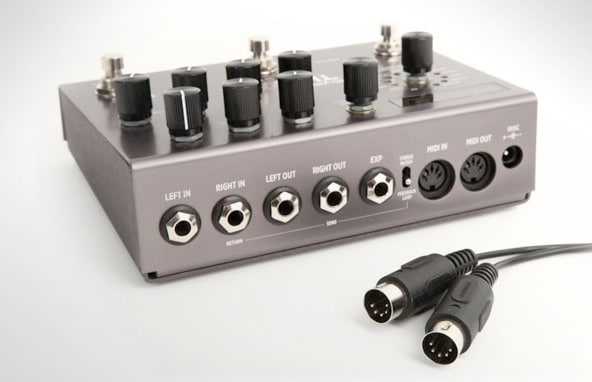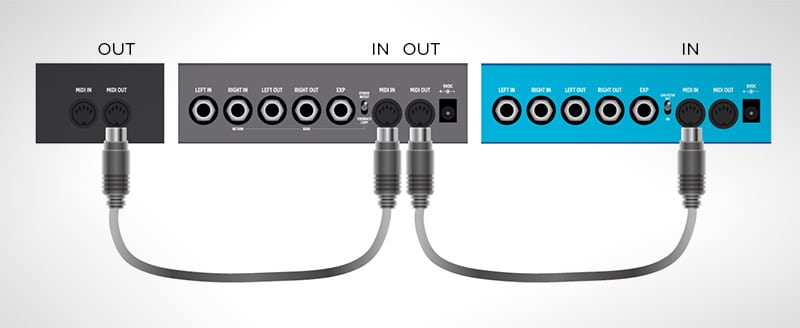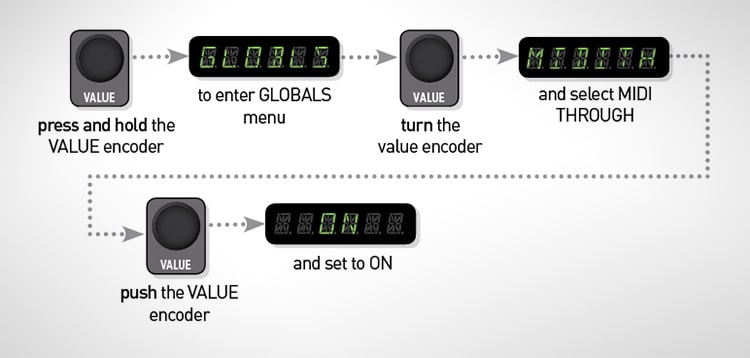![Dave Depper from Death Cab For Cutie Pedalboard]()
Looking for someone that enjoys talking gear? Dave Depper is your person. He said so himself here ![🙂]() Now with Death Cab For Cutie, Dave has stayed busy playing and recording with a slew of great artists. He also has kept his talent going with solo projects including one where he did a cover album of Paul McCartney’s Ram, titled The Ram Project.
Now with Death Cab For Cutie, Dave has stayed busy playing and recording with a slew of great artists. He also has kept his talent going with solo projects including one where he did a cover album of Paul McCartney’s Ram, titled The Ram Project.
![Dave Depper Fano Guitar]() What kind of pedalboard is this, and what is your signal path?
What kind of pedalboard is this, and what is your signal path?
I’m using a Pedaltrain 2 board, and powering everything with a Voodoo Lab Pedal Power Mondo.
My main guitars are both made by Fano. One is the PX6, which is loosely based on a non-reverse Gibson Firebird, and it has Lollar Firebird pickups installed. The other is the GF6, which in turn is inspired by the Fender Starcaster, and it has Fralin P90s in it.
![Dave Depper Fano Guitar]()
I’m also using a Rickenbacker 330 12-string on several numbers, as well as an old Martin D-28 of Ray LaMontagne’s which he very kindly gave me at the end of our run together last year.
My signal path, in order:
TC Electronic Polytune Mini – not much to say about this one other than it’s small and convenient!
Earthquaker Devices Fuzz Master General – incredible little nuclear bomb of a pedal, it’s EQD’s spin on the Ace Tone Fuzz Master, and dang, does it sound good. I’m currently using it to play the guitar solo on the Death Cab single “Black Sun” – it needs a very specific octave-fuzzy kind of sound, and this pedal nails it.
ARC Effects Klone V2 – ARC is a really wonderful builder in upstate NY. His handiwork is beautiful and he’s a total pleasure to work with. The Klone, as the name implies, is a faithful recreation of a Klon Centaur. Obviously, this is a cottage industry these days, and there’s many Klon clones to choose from, but of all the ones I’ve tried, this one just NAILS it. Also, there’s an optional bass boost switch which ably makes up for some of the low frequency drop that this type of pedal is known for at higher gain settings.
I use the Klone for mild overdrive and as a dirty boost – volume around 10 o’clock, tone at noon, and gain ranging from 9 to 1 o’clock, depending on the song. I have it on about 80% of the time.
Xotic BB Preamp – Possibly my favorite pedal of all time. In Death Cab, I’m using it for my medium to heavy gainl/lead tones. However, I’ve used this pedal for years in all sorts of roles, from a clean boost to a dirty boost to a simple EQ to a rock distortion machine.
My original BB Preamp got wet during soundcheck at Red Rocks at our show earlier this year, I foolishly didn’t have a backup, and the thing shorted out during the second song. I had a disaster of an evening as a result, so dependent am I on this miracle baby. I learned my lesson and have three now!
Catalinbread Dirty Little Secret – Another incredible device, this is the best Marshall-in-a-box pedal I’ve come across. It has a both a Super Lead and a Super Bass mode, selectable via an internal slider switch. I use this one for really high-gain stuff like “The New Year” and “We Laugh Indoors.”
Mr. Black Boost Tiger – my favorite transparent boost, made in Portland to boot. Sadly discontinued.
Strymon TimeLine – More on this during the next question!
Strymon BigSky – see above!
Disaster Area DMC-3XL – genius MIDI foot controller. I have many different presets on both Strymon pedals, so this pedal essential creates a master preset on a song by song basis out of a combination of the two, and I can scroll through it rapidly and intuitively. It also includes a shortcut to the looping function on the TimeLine pedal, which comes in VERY handy.
![Dave Depper from Death Cab For Cutie Pedalboard]()
Please tell us a bit about how you use BigSky during your Death Cab For Cutie set. Also, can you tell us about how the FOH uses BigSky?
The BigSky and the TimeLine are both fundamental components of my live sound.
With the BigSky, about half the time I am using the Spring reverb machine, especially on the rockier songs. I like running my amp very clean and effect-free, getting most of my tonal variation from my pedalboard. I adore the Spring machine’s warm, natural sound.
My favorite application, however, is the Bloom machine. It’s quite simply my favorite reverb sound I’ve ever encountered, and I use it pretty liberally throughout the set, especially during the slower, more atmospheric songs like “Transatlanticsm” and “You’ve Haunted Me All My Life.” And I ESPECIALLY love holding down the switch to engage the Infinite Sustain when using the Bloom machine. Freezing the sound in place like that ends up sounding almost like a synth pad, and it’s kind of like having a piano sustain pedal for my guitar. I use this trick fairly often throughout the set.
I’m just as reliant on the TimeLine, and have a different present built for nearly every song. I use the Digital machine for U2-like syncopated delays in songs like “You Are a Tourist” and “Your Heart Is An Empty Room.” I use the Analog machine for subtle slapback in songs like “Cath…” and “Why You’d Want To Live Here.” And the Tape machine comes in handy for all-out mayhem on “I Will Possess Your Heart” and “Bixby Canyon Bridge.” I definitely find myself abusing the self-oscillation function several times throughout the set.
With Death Cab For Cutie you have played on Jimmy Kimmel and Conan. What is it like getting ready to perform on late night? Is performing on late night shows all the same, or is there some differences?
I’m not going to lie – it’s a very nerve-wracking experience! When playing a full-length show, even if it’s a high-pressure one, you still have a couple of hours to settle in and get comfortable over the course of the performance. And even if you make a few mistakes here and there, overall a good show is a good show.
With TV, you have three minutes to flawlessly play a song, cold, and know that it’s being watched by several million people, frozen in amber forever on YouTube, etc.
And yes, all of the shows are fairly different experiences. With Letterman, for example, he wasn’t hanging around the studio beforehand – the first time you’d see him would be two minutes before you performed the song, when you’re brought down from the green room and told to take your places on the stage and there he was at his famous desk. Fallon and Conan, by contrast, make a point to say hi and make you feel comfortable earlier in the day. Not a knock on Letterman at all – he’d been doing it for 30-odd years and I don’t blame him for streamlining his day!
Each show has its own specific vibe and backstage culture that is more or less a reflection of the host’s personality. And they’re all a blast.
![Guitarist Dave Depper]() What was your first break in becoming a working musician?
What was your first break in becoming a working musician?
Well, I don’t know if I’ve necessarily had any “breaks” that I can particularly identify. Every project I’ve been involved in has seemed like a pretty organic progression from the last.
But in terms of being a paid professional, I suppose I can pinpoint the beginning of that – seven or eight years ago, I was a member of a great band called Norfolk and Western. The drummer, Rachel Blumberg, also happened to drum for M. Ward. Ward produced an album by Jolie Holland called “The Living and the Dead” and used Rachel as the drummer. When it came time for Jolie to put together a touring band, Rachel was a part of it from the get go and she recommended me as the bass player. So that was my first experience as a touring “hired gun, ” so to speak – playing bass for Jolie Holland.
What are some must go to venues in Portland to see a band? Which one would be a must perform at venue?
My favorite venue in the world happens to be in Portland – the Doug Fir. It was designed from the ground up with great sound and performer/audience experience in mind. Both performing and seeing shows there is a treat. I’ve played there dozens of times.
Other great spots include Mississippi Studios, Holocene, Revolution Hall, and the Crystal Ballroom.
The post Pedalboard Feature: Dave Depper appeared first on Strymon.















 Jazz guitarist
Jazz guitarist 








 Now with
Now with  What kind of pedalboard is this, and what is your signal path?
What kind of pedalboard is this, and what is your signal path?

 What was your first break in becoming a working musician?
What was your first break in becoming a working musician? 


